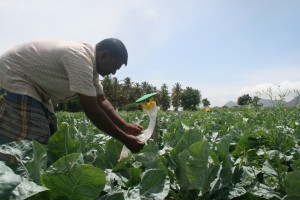 While South Asia is no stranger to volatile weather conditions, intensifying variability in climate patterns can potentially wreak havoc upon the region’s fragile communities. On February 7, the Woodrow Wilson Center hosted a panel entitled “Strengthening Responses to Climate Variability in South Asia”. Featuring new research from International Alert, discussion focused on isolating the root causes of climate vulnerability and how external interventions could address those factors to prevent conflict or regional destabilization. International Alert based their investigation on case studies in Bangladesh, India, Nepal, and Pakistan.
While South Asia is no stranger to volatile weather conditions, intensifying variability in climate patterns can potentially wreak havoc upon the region’s fragile communities. On February 7, the Woodrow Wilson Center hosted a panel entitled “Strengthening Responses to Climate Variability in South Asia”. Featuring new research from International Alert, discussion focused on isolating the root causes of climate vulnerability and how external interventions could address those factors to prevent conflict or regional destabilization. International Alert based their investigation on case studies in Bangladesh, India, Nepal, and Pakistan.
There are a few notable trends, despite a diversity of studies. Unpredictable climate variability presents problems for these populations and adaptive behaviors generally evolve on the communal level. Also, across all four case studies, climate change is identified as an influence of migratory patterns through increased populations among those who move from rural to urban areas.
Several factors complicate implementing region-wide responses to these issues, including local power dynamics, water security, and conflicts of interest. Identifying the problems is far easier than putting solutions into practice. David Michel, senior associate and director of the Environmental Security program at the Stimson Center, spoke to this issue
Take the issue of water distribution and management. Water, by its nature, is a trans-boundary resource, making local solutions difficult because water crosses different villages, states and countries. People living in mountainous regions, for example, face a depleting water supply due to melting glaciers and snow packs and would potentially find a dam beneficial. However, for those living downstream, a dam would reduce or cut off important water access.
Another sticky issue is industrial development. For example, some Nepali farmers have started investing in high value agriculture. In a way this is good, because crops such as chamomile and lemon grass are more resistant to changing weather patterns than rice. On the other hand, this is detrimental to non-landowning farmers because these crops require less manual labor than paddies. Decreased employment in the farming sector is resulting in growth for less sustainable industries such as furniture making. While the industries vary among case studies, the struggle to develop resilient, sustainable industries is a common issue.
The lack of economic opportunity is also influencing another major issue: migration. Mostly from rural to urban areas, the increase in migratory populations is putting strain on cities which are already limited in resources. Not only do rural communities suffer from a “brain drain,” but also, the growing population in urban areas could lead to conflict and security issues.
These are the challenges in the path of increasing resilience to climate change in South Asia. On the whole, the research identified five areas for improvement that would help promote resilience in the region: effective governance and communication between state and local level officials; fair management and access to natural resources; the advancement and promotion of climate-sensitive alternative livelihoods; fair access to credit; and safe management of migrating populations. It can be done, but future policy makers locally, nationally, and internationally have their work cut out for them.


